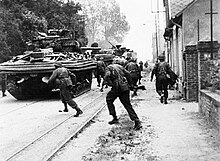
Juno or Juno Beach was one of five beaches of the Allied invasion of German-occupied France in the Normandy landings on 6 June 1944 during the Second World War. The beach spanned from Courseulles, a village just east of the British beach Gold, to Saint-Aubin-sur-Mer, and just west of the British beach Sword. Taking Juno was the responsibility of the First Canadian Army, with sea transport, mine sweeping, and a naval bombardment force provided by the Royal Canadian Navy and the British Royal Navy as well as elements from the Free French, Norwegian, and other Allied navies. The objectives of the 3rd Canadian Infantry Division on D-Day were to cut the Caen-Bayeux road, seize the Carpiquet airport west of Caen, and form a link between the two British beaches on either flank.
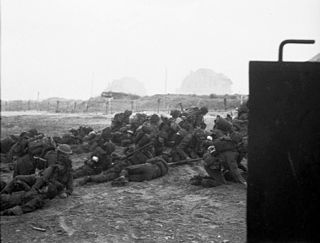
Sword, commonly known as Sword Beach, was the code name given to one of the five main landing areas along the Normandy coast during the initial assault phase, Operation Neptune, of Operation Overlord. The Allied invasion of German-occupied France commenced on 6 June 1944. Stretching 8 kilometres (5.0 mi) from Ouistreham to Saint-Aubin-sur-Mer, the beach proved to be the easternmost landing site of the invasion after the abortion of an attack on a sixth beach, code-named Band. Taking Sword was to be the responsibility of the British Army with sea transport, mine sweeping and a naval bombardment force provided by the British Royal Navy as well as elements from the Polish, Norwegian and other Allied navies.

Operation Goodwood was a British offensive during the Second World War, which took place between 18 and 20 July 1944 as part of the larger battle for Caen in Normandy, France. The objective of the operation was a limited attack to the south, from the Orne bridgehead, to capture the rest of Caen and the Bourguébus Ridge beyond.

The Battle of Villers-Bocage took place during the Second World War on 13 June 1944, one week after the Normandy Landings, which had begun the Western Allies' conquest of German-occupied France. The battle was the result of a British attempt to improve their position by exploiting a gap in the German defences west of the city of Caen. After one day of fighting in and around the small town of Villers-Bocage and a second day defending a position outside the town, the British force retreated.

Operation Epsom, also known as the First Battle of the Odon, was a British offensive in the Second World War between 26 and 30 June 1944, during the Battle of Normandy. The offensive was intended to outflank and seize the German-occupied city of Caen, an important Allied objective, in the early stages of Operation Overlord, the Allied invasion of north-west Europe.
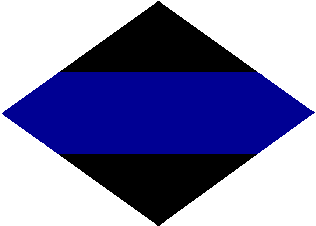
The 2nd Canadian Armoured Brigade was an armoured brigade of the Canadian Army that saw active service during World War II. The brigade was composed of the 6th, 10th and 27th Canadian Armoured regiments and saw service in northwest Europe, landing in Normandy on D-Day and remaining in combat up to Victory in Europe Day.

Gold, commonly known as Gold Beach, was the code name for one of the five areas of the Allied invasion of German-occupied France in the Normandy landings on 6 June 1944, during the Second World War. Gold, the central of the five areas, was located between Port-en-Bessin on the west and the Lieu-dit La Rivière in Ver-sur-Mer on the east. High cliffs at the western end of the zone meant that the landings took place on the flat section between Le Hamel and La Rivière, in the sectors code-named Jig and King. Taking Gold was to be the responsibility of the British Army, with sea transport, mine sweeping, and a naval bombardment force provided by the Royal Navy as well as elements from the Dutch, Polish and other Allied navies.

Operation Charnwood was an Anglo-Canadian offensive that took place from 8 to 9 July 1944, during the Battle for Caen, part of the larger Operation Overlord in the Second World War. The operation was intended to capture the German-occupied city of Caen, which was an important objective for the Allies during the opening stages of Overlord. It was also hoped that the attack would forestall the transfer of German armoured units from the Anglo-Canadian sector to the American sector to the west, where an offensive was being prepared. The British and Canadians advanced on a broad front and by the evening of the second day had taken Caen up to the Orne and Odon rivers.

The 43rd (Wessex) Infantry Division was an infantry division of Britain's Territorial Army (TA). The division was first formed in 1908, as the Wessex Division. During the First World War, it was broken-up and never served as a complete formation. It was reformed in the TA in 1920, and then served in the campaign in North West Europe from June 1944 until May 1945, during the Second World War. The division suffered heavy casualties and gained an excellent reputation. After the Second World War, the division formed part of the postwar TA, and became the 43rd (Wessex) Division/District in 1961. It was finally disbanded in 1967.

The 8th Armoured Brigade was an armoured brigade of the British Army formed in August 1941, during the Second World War and active until 1956. The brigade was formed by the renaming of 6th Cavalry Brigade, when the 1st Cavalry Division based in Palestine converted from a motorised formation to an armoured unit, becoming 10th Armoured Division.

Operation Jupiter was an offensive by VIII Corps of the British Second Army from 10 to 11 July 1944. The operation took place during the Battle of Normandy in the Second World War. The objective of the 43rd (Wessex) Infantry Division was to capture the villages of Baron-sur-Odon and Fontaine-Étoupefour and Chateau de Fontaine-Étoupefour, and to recapture Hill 112. An attached brigade of the 15th (Scottish) Infantry Division would take Éterville, Maltot and the ground up to the River Orne and then the tanks of the 4th Armoured Brigade, supported by infantry, would advance through the captured ground and secure several villages to the west of the River Orne. It was hoped that the initial objectives could be captured by 9:00 a.m., after which the 4th Armoured Brigade would exploit the success.

Operation Perch was a British offensive of the Second World War which took place from 7 to 14 June 1944, during the early stages of the Battle of Normandy. The operation was intended to encircle and seize the German occupied city of Caen, which was a D-Day objective for the British 3rd Infantry Division in the early phases of Operation Overlord. Operation Perch was to begin immediately after the British beach landings with an advance to the south-east of Caen by XXX Corps. Three days after the invasion the city was still in German hands and the operation was amended. The operation was expanded to include I Corps for a pincer attack on Caen.

The Northumberland Hussars was a Yeomanry regiment of the British Army, transferred to the Royal Artillery for the duration of the Second World War. It was disbanded as an independent Territorial Army unit in 1967, a time when the strength of the Territorial Army was greatly reduced. The regiment's name lives on in the title of the command and support squadron of the Queen's Own Yeomanry (QOY), a Formation Reconnaissance Regiment based in Newcastle upon Tyne.
The 33rd Armoured Brigade was an armoured brigade of the British Army that was active in northwestern Europe in the Second World War from June 1944 until May 1945 and from 1980 to 1992.
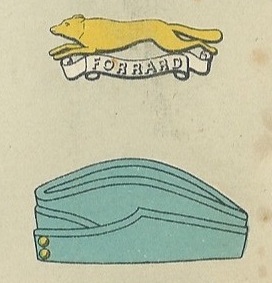
The East Riding of Yorkshire Yeomanry was a unit of the British Army formed in 1902. Units of Yeomanry Cavalry were raised in the East Riding of Yorkshire in the 18th and early 19th centuries at times of national emergency: the Jacobite Rising of 1745, the French Revolutionary Wars and the Napoleonic Wars. These were stood down once each emergency was over. The East Riding of Yorkshire Yeomanry, was established in 1902, and this saw action during the First World War both in the mounted role and as machine gunners.

Operation Martlet was part of a series of British attacks to capture the French town of Caen and its environs from German forces during the Battle of Normandy of World War II begun by the Allies. It was a preliminary operation undertaken on 25 June 1944 by XXX Corps of the British Second Army, to capture Rauray and the area around Noyers. The attack was to protect the right flank of VIII Corps as it began Operation Epsom, an offensive into the Odon Valley west of Caen, on 26 June. The 50th (Northumbrian) Infantry Division and the 49th Infantry Division were to capture Juvigny-sur-Seulles, Vendes and Rauray, to prevent German counter-attacks against VIII Corps from the area of the Rauray Spur and then extend the attack towards Noyers and Aunay-sur-Odon. It was the first time in Normandy that the 49th Division operated as a division.
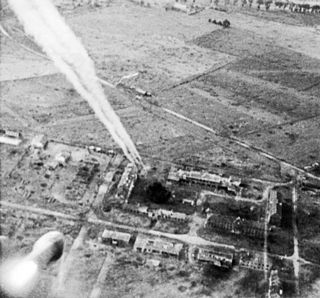
Operation Windsor(4–5 July 1944), was a Canadian attack of the Battle of Normandy during the Second World War. The attack was undertaken by the 3rd Canadian Infantry Division to take Carpiquet and the adjacent airfield from troops of the 12th SS-Panzer Division Hitler Jugend of Panzergruppe West. The attack was originally intended to take place during the later stages of Operation Epsom, to protect the eastern flank of the main assault but was postponed for a week.

The Second Battle of the Odon comprised operations fought by the British Second Army during the Second World War. Attacks took place in mid-July 1944 against Panzergruppe West, as part of the Battle of Normandy. Operations Greenline and Pomegranate were intended to draw German attention away from Operation Goodwood, an attack from the Orne bridgehead on 18 July.
The 153rd Regiment Royal Armoured Corps was an armoured regiment of the Royal Armoured Corps, part of the British Army, and was raised during the Second World War. The regiment saw brief but intense action in the invasion of Normandy before being broken up to provide replacements to other units.

The Staffordshire Yeomanry, Royal Armoured Corps, was a tank regiment of Britain's Territorial Army converted from Yeomanry Cavalry serving in the Middle East during the Second World War. It fought at the Battles of Alam el Halfa and El Alamein in the Western Desert and the subsequent Tunisian campaign, distinguishing itself at the Battle of Tebaga Gap. It was then withdrawn to the UK to prepare for Operation Overlord, and landed on Sword Beach on D-Day. Subsequently, it was converted to operate amphibious tanks, and served in this role in the Battle of the Scheldt and the crossings of the Rhine and Elbe. Postwar, the Staffordshire Yeomanry remained part of the Royal Armoured Corps through various amalgamations.


